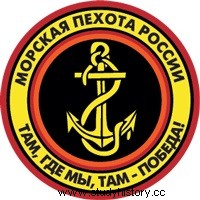
The Marine Infantry (Russian:Morskaya pekhota) is the amphibious armed force of the Russian Navy. In service since 1705, when it was founded, it fought in the Napoleonic Wars, the Crimean War, the Russo-Japanese War as well as the First and Second World Wars. Under the Soviet era, it was by decision of Admiral Gorshkov that the Russian Navy was provided with a marine infantry which will intervene throughout the world on numerous occasions. After the fall of the Soviet Union, the Russian naval troops experienced difficult times with the entire Soviet armed forces, characterized by a sharp decrease in equipment and manpower.
In the 18th and 19th centuries
It was in November 1705, following a decree of Peter I, that a "naval crew" regiment equipped and supplied by the Imperial Russian Navy was for the first time formed for embarkation and landing from the ships of the Baltic Fleet in an amphibious operation.
The 18th century was also the baptism of fire for the Russian marine infantry, which took part in several famous battles which ended in brilliant victories. The battle of Gangut (1714), the rout of the Turkish navy at Cesme Harbor in 1770 and finally the capture of the fortress of Ismail on the Danube in 1790 are significant examples.
In 1799, during the Napoleonic wars, Russia took the French fortress of Corfu. That same year, the Russian landing in Naples reached the Papal States. During the War of the Sixth Coalition, the Russian Marines distinguished themselves against the Grand Army at the Battle of Borodino (1812), the Battle of Kulm (1813), and the Siege of Danzig.
From 1854 to 1855, the Marines defended Sevastopol against France, the United Kingdom and Turkey.
During the year 1904, during the Russo-Japanese war, the marine infantry defended Port Arthur against the Japanese forces.
Soviet era
World War II
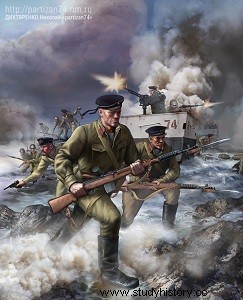
During World War II, approximately 350,000 soldiers of the Russian Marines fought on the Eastern Front. At the beginning of the conflict, the navy had only one brigade of marines from the Baltic Fleet, which implied the need to form other battalions during the war. Thus were formed:
6 marine infantry regiments comprising two battalions each with a staff of 650 men,
40 brigades and several battalions formed from surplus ships' crews of which five of these brigades have been elevated to the status of "Guards of the Soviet Union".
many small units.
The military situation required the deployment of a large number of sailors to the front, which allowed them to contribute to the defense of Moscow, Leningrad, Odessa, Sevastopol, Stalingrad, Novorossiysk and Kerch.
The Russian Marine Infantry carried out more than 114 landings, most of which were carried out by platoons and companies. It should be noted, however, that many Marines who served in the regular infantry had received no amphibious training.
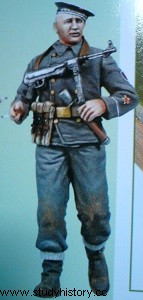
during World War II, Russian naval troops conducted four major amphibious operations:two during the Battle of the Kerch Peninsula, one during the Caucasus campaign and finally, one as part of the Moonsund landing in the Baltic Sea.
During the war, five brigades and two battalions of marine infantry received the status of Guards of the Soviet Union. Nine brigades and six battalions were decorated and many others received several honorary titles. The title of Hero of the Soviet Union was awarded to 122 members of marine infantry units.
After the war, the experience of amphibious battles accumulated during the Second World War was a major asset for the Soviet Union during joint operations with its allies. In addition, many elements of the Russian marine infantry were trained in parachuting and thus carried out more operations than the Russian own airborne troops.
Despite their stellar record of service, the Russian Marine Infantry Troops were disbanded in 1947 with a few units being transferred to the Coastal Defense Forces.
Cold War

In 1961, the Marine Infantry was reformed and once again became one of the armed arms of the Soviet naval forces. For each of the fleets of the USSR, a marine infantry unit was assigned, to which a brigade was later added. During this period, the Marines received several amphibious versions of armored fighting vehicles, including tanks in service with the Red Army.
In 1989, the Marine Infantry consisted of 18,000 soldiers organized in the 55th Marine Infantry Division from Vladivostok and three autonomous brigades:the 63rd Guards "Kirkenneskaya" Brigade from Pechenga (Northern Fleet), the 36th Guards Brigade from the Baltiisk Guard (Baltic Fleet) and the Sevastopol Brigade (Black Sea Fleet).
At the end of the Cold War, the Soviet Navy had only eighty landing ships and two ships of the "Ivan Rogov" class which could transport an entire battalion of infantry with 40 armored vehicles and their barges. landing. Currently, one of these ships has been retired.
With 75 units, the Soviet Union had the largest combat hovercraft arsenal in the world. In addition, it is interesting to note that a good number of the 2,500 ships of the Merchant Fleet of the Soviet Union (Morflot) could incidentally unload weapons and supplies during amphibious operations.
On July 14, 1991, a proclamation of the Soviet government, which was subsequently adopted by the successor states, laid down the conditions for a "restriction in armament and conventional equipment" (tanks, artillery and armored vehicles) assigned to the infantry of navy or coastal defense forces.
Russian Federation
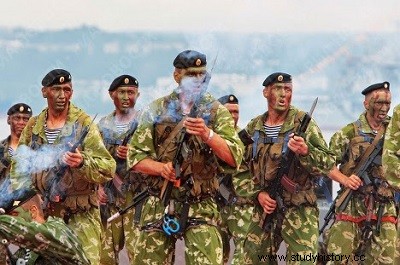
Russian Navy Infantry (video) includes 55th Division fleet of the Pacific Fleet, the independent brigades of the North Sea and the Baltic, the fleet of military vehicles of the Caspian Flotilla and the independent regiments of the Black Sea Fleet. The main Arctic base of the Northern Fleet Marines is called Sputnik.
In 1994, the military exercise called "Cooperation from the sea" was conducted in the Vladivostok perimeter with the "III Marine Expeditionary Force" of the United States to foster a closer relationship between the Russian Marines and the Marines Americans. Together, the two forces conducted their first exercise on American soil the following year, in Hawaii. The 1995 “cooperation from the sea” created a space for maritime exercise in the event of an “emergency situation” which included cross-training with exchange of personnel. This operation culminated in the exercise of a combined amphibious assault by Russian and American forces. The goal was to improve interoperability, cooperation and understanding between Russian and United States personnel.
From 2000, the Caspian Flotilla included a new marine infantry brigade, the 77th, based in Kaspiisk. The brigade's headquarters and two battalions were to be set up on 1 August 2000. It was reported by Agenstvo Voyenniykh Novostyei (AVN) in June 2000 that the new brigade (which may have inherited the 77th Motorized Rifle Division) was accommodated in Kaspiysk and Astrakhan with 195 combat vehicles and two hovercraft sent from Chukotka by the Northern Fleet. The brigade also reported having helicopters assigned to it.
Missions
For each of the main Russian fleets, there is at least one marine infantry regiment attached to them. In total, the strength of the Russian marine infantry is about 12,000 men. This force has limited striking power and support means, theoretically requiring reinforcement in operation in less than a week. This is explained by the Russian military doctrine which considers the marine infantry as being a shock troop, the spearhead of a rapid attack which must imperatively be followed by the reinforcements of the land armed forces deploying heavy equipment.
The main missions of the Russian Marine Infantry would be to seize and defend strategic straits or islands, to arrange tactical maritime landing zones behind enemy lines and the defense of critical naval areas. During the 1980s, Soviet naval infantry exercises in the Kuril Islands in northern Japan seemed to indicate that strategic objectives in this region were spread across different shores and bottlenecks.
For example, during a conflict, the objective of these troops would most likely be the capture of a strait such as the Dardanelles or Kattegat by landing on land from the Black Sea in the first case, or from the North Sea in the second case. This attack would be immediately followed by a rapid reinforcement by the Russian army, both in manpower and heavy equipment.
Current deployment
Pacific Fleet
55th Marine Infantry Division - Vladivostok; now disbanded, with the 165th Marine Infantry Brigade formed on its base.
165th "Cossack" Marine Infantry Regiment - deployed in the brigade.
390th Marine Infantry Regiment – disbanded.
106th Marine Infantry Regiment Marine – disbanded 1 Dec 2007.
921st Marine Infantry Artillery Regiment – disbanded.
923rd Marine Infantry Anti-Aircraft (missiles ) – disbanded.
84th Combat Tank Marine Infantry Battalion.
263rd Reconnaissance Battalion.
1484th Combat Tank Battalion. forwarding.
The 40th Marine Infantry Brigade "Krasnodar-Harbin", twice awarded the Order of the Red Banner.
The 186th Marine Infantry Engineer Battalion
Baltic Fleet
299th Baltic Fleet Coastal Area Training Center Forces.
336th Guards Marine Infantry Brigade “Bialystok” (Order of Suvorov and Alexander Nevsky – Baltiysk.
724th Reconnaissance Battalion – Mechnikovo.
877th Battalion
878th Separate Marine Infantry Battalion.
879th Airborne Battalion (Desant).
1592nd Self-Propelled Artillery Battalion.
1612th Artillery Battalion.
1618th Anti-Aircraft Artillery Battalion (anti-missile and aircraft)
9th naval crew – platoon of Marine Infantry military escort of freight ship (cargo) – Sappers.
Northern Fleet
61st “Kirkinesskaya” Marine Infantry Brigade of the Order of the Red Banner – Sputnik.
Brigade Headquarters.
874th Infantry Battalion
876th Airborne Battalion (Desant).
886th Reconnaissance Battalion.
125th Main Battle Tank Battalion.
1611th Self-Propelled Artillery Battalion.
1591st Self-Propelled Artillery Battalion.
1617th Anti-Aircraft Artillery Battalion (anti-missile and aircraft)
75th Marine Hospital
317th Marine Infantry Battalion.
318th Marine Infantry Battalion .
Black Sea Fleet
810th Marine Infantry Brigade - Kazachye Bukhta, Sevastopol.
882nd Regiment and a separate assault battalion.
382nd and a separate battalion.
A tank battalion.
Caspian Fleet
77th Guards Marine Infantry Brigade "Moscow-Chernigov", Order of Lenin and the Red Banner, Order of Suvorov - Kaspiysk
Moscow
Independent Battalion – Moscow.
A military escort company of cargo ships – Moscow.
Organization
A marine infantry regiment, equipped with PT-76 and BRDM-2 vehicles, consists of a combat tank battalion and three marine infantry battalions, including one motorized with BTR-60 amphibious vehicles.
A marine infantry brigade, equipped with the PT-76 or the T-80 and BRDM-2 assault tank, consists of 2 tank battalions, and 4 to 5 marine infantry battalions, including one motorized with the BTR-60 amphibious vehicles. A tank battalion, originally had 36 combat tanks. At least one infantry battalion is trained in airborne operations, while all other infantry battalions are trained to be able to perform airborne missions.
Equipment
The Russian Marines have gradually received the PT-76 amphibious tank, but have not yet received the T-80 heavy assault tank in large numbers. At full strength, a Russian marine infantry brigade can have 70-80 tanks. The personnel carriers used by the marine infantry are either BTR-80 (in airborne battalions) or MT-LBs (in landing battalions). Although marine infantry units were supposed to receive the BMP-3 infantry fighting vehicle, few have been delivered and it is far from certain that such a rearmament will take place. The BMP-3 can equip one company per battalion.
According to the Ministry of Defense in a statement published by RIA Novosti (November 27, 2009), "All Russian marine infantry units will be fully equipped with modern weapons by 2015." This update of the Russian army will include the T-90, BMP-3 tanks, the 2S31 120 mm self-propelled artillery mortar, the BTR-82A armored personnel carrier, large and small-caliber air defense equipment5. However, in 2011, no units received new weapons due to budgetary problems faced by Russia. However, some T-80 heavy tanks are currently in service.
Heroes of the Soviet Union and the Russian Federation
Heroes of the Soviet Union
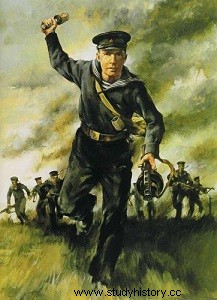
Marin Avramenko Mikhail (1945)
Officer Noah P. Adamia (1942)
Sergeant Petrovich Artemov Pavel (1945)
Lieutenant Mikhail Ashik (1946)
Sailor Balyaev Illarionovich Yakov (1945)
Major Barabolko Mikhail (1945)
Officer Sergey G. Zimin (1943, shironintsy)
Sailor Kafur Nasyrovich Mamedov (1942, posthumous)
Marin Pavel D. Osipov (1945, posthumous)
Marin Ahmed Abdulmedzhidov Dibirovich (1945)
Private Andrey Arkadevich Skvortsov (1943, shironintsy)
Private Aleksandr Fedorovich Toropov (1943, shironintsy)
Lieutenant Pierre Shironin (1943, shironintsy)
Major Caesar Lvovich Kunikov (1943 , posthumous)
Heroes of the Russian Federation
Officer Azarychev Gennadiy Starshina. (1995)
Lieutenant Vladimir A. Belyavskiy (2006)
Lieutenant Vladimir V. Borovikov
Captain Vdovkin Viktor
Major Gaponenko Pavel Nikolaevich
Major Andrey Y. Gushchin (1995)
Lieutenant of the Guard Darkovich Aleksandr (1995)
Officer Dneprovskiy Andrey Vladimirovich
Senior Officer Zamyshlyak Mikhailovich Gregory
Major Andrey N. Zakharchuk
Lieutenant of the Guard Vladimir V Karpushenko
Lieutenant Colonel Klimenko Nikolayevich Dmitriy
Captain of the Guard Yevgeniy N. Kolesnikov (1995, posthumous)
Major- General Kocheshkov Nikolayevich Yevgeniy
Lieutenant Kuryagin Gerasimovich Yuriy
Major-General Aleksandr Otrakovskiy (2000, posthumous )
Captain of the Guard Dmitriy Polkovnikov (1995)
Sailor Tatashvili Vladimir Vladimirovich
Lieutenant Firsov Sergey
Colonel Chernov Aleksandr
Major General of the Guard Sheiko Sergey (1995)
Major General Shulyak Viktor
Shipping
The tank landing craft "Alligator" was a typical amphibious assault ship. Powered by diesel engines, this vessel is relatively low tonnage with a displacement of around 4,500 tons. In 1978, the Soviets launched a new amphibious ship, named "Ivan Rogov". The arrival of the "Ivan Rogov" class was taken in the Western bloc as an indication that the Soviet Navy intended to strengthen its military projection capabilities by increasing the power of its naval infantry. Twice the size of the ships that preceded it, the "Ivan Rogov" class can launch multiple amphibious vehicles from its open bow doors and also launches helicopters. Among the various small landing craft it can dispatch are hovercraft such as the "Aist", which can carry marine infantry ashore at speeds of fifty knots.
